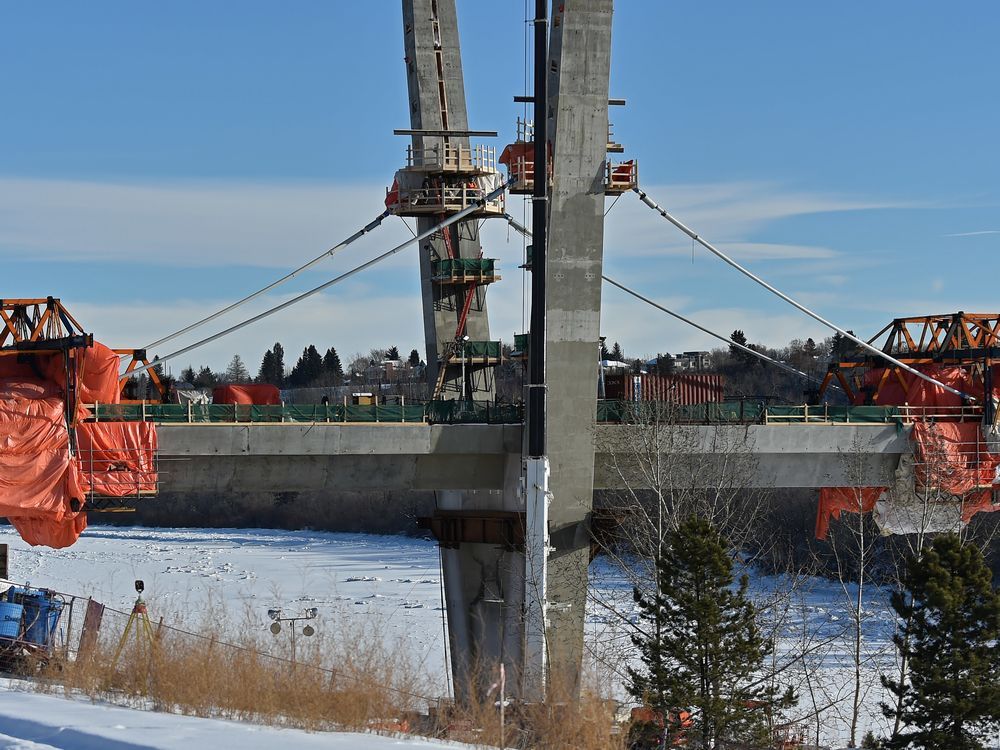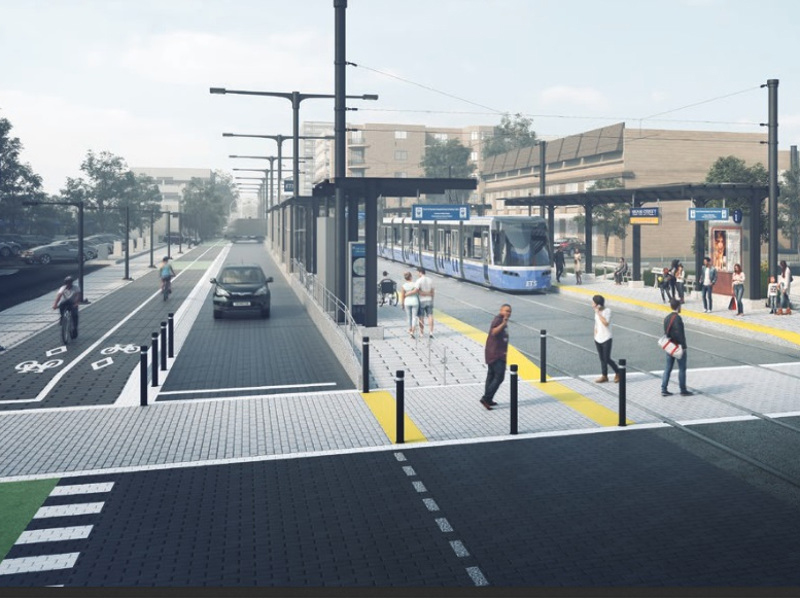It still has its own right of way though and won't be impacted by congestion. If there is gridlock, it will still be moving faster than vehicles will be. I'm back to driving downtown for work, but there are definitely days (any day it snows) where the new LRT would be faster, even from only Bonnie Doon. That and the fact you are not sitting in traffic yelling at poorly skilled drivers is a pretty good reason to take transit.
You are using an out of date browser. It may not display this or other websites correctly.
You should upgrade or use an alternative browser.
You should upgrade or use an alternative browser.
Valley Line LRT/ Valley Line West | ?m | ?s | City of Edmonton
- Thread starter Daveography
- Start date
Member Bio
- Joined
- Sep 22, 2015
- Messages
- 10,218
- Reaction score
- 23,063
- Location
- Edmonton, Alberta, Canada
@Aaron_Lloyd We weren't going to be able to afford anything but a surface-running line. Tunnelling and elevated guideways are just too expensive.
It's really a catch-22; we don't have the density to support funding grade-separated rapid transit, but we can't get the density increases we need without investing in mass transit.
It's honestly the best we can do at this stage of our development. And that's not a bad thing. It is already doing a lot to help build up communities around the line, while true separated rapid transit tends to be more in the service of commuting from the furthest communities from the city centre. Plus the accessibility of surface stations for people with mobility issues, as well as for those who use bikes for the "last mile" is unmatched.
And remember, there are cities much larger than ours that either already use this type of LRT, and/or are currently building it. Cities like Toronto, Sydney, Portland, Melbourne, Seattle, etc.
It's really a catch-22; we don't have the density to support funding grade-separated rapid transit, but we can't get the density increases we need without investing in mass transit.
It's honestly the best we can do at this stage of our development. And that's not a bad thing. It is already doing a lot to help build up communities around the line, while true separated rapid transit tends to be more in the service of commuting from the furthest communities from the city centre. Plus the accessibility of surface stations for people with mobility issues, as well as for those who use bikes for the "last mile" is unmatched.
And remember, there are cities much larger than ours that either already use this type of LRT, and/or are currently building it. Cities like Toronto, Sydney, Portland, Melbourne, Seattle, etc.
Aaron_Lloyd
Active Member
I just don't think we should be spending $1.6 billion for a system barely better than BRT, if it was going to cost more to build it properly we should have waited until we could build an appropriate system. This is the same type of thinking that leads to us spending $80 million on a renovation to make our central library uglier. "We can't afford better right now, so let's just go with the cheap a crappy option!" just doesn't seem to be a good mentality for the city to have.
Also I would question whether a better system would actually need to be more costly anyways, to my understanding much of the reason this line will be barely more than half the speed of the Capital Line has to do with deliberate design choices to be more "urban". I don't think full grade separation would be required for a version of this line to run at a higher speed. The Capital Line doesn't run slower than the surrounding cars on its at-grade portions.
Also I would question whether a better system would actually need to be more costly anyways, to my understanding much of the reason this line will be barely more than half the speed of the Capital Line has to do with deliberate design choices to be more "urban". I don't think full grade separation would be required for a version of this line to run at a higher speed. The Capital Line doesn't run slower than the surrounding cars on its at-grade portions.
Last edited:
Member Bio
- Joined
- Sep 22, 2015
- Messages
- 10,218
- Reaction score
- 23,063
- Location
- Edmonton, Alberta, Canada
@Aaron_Lloyd BRT can't match the capacity needed, while the costs are nearly the same infrastructure-wise, and in fact higher operationally than LRT.
No, maybe grade separation might not be needed for higher speeds, but the tradeoff is that the tracks would need to be isolated from the roadways with fences that divide communities and would require pedestrians to go further to be able to cross the tracks at intersections, which would need crossing gates and bells to give the trains full priority.
If that's what they were proposing through my community, instead of what we're getting, I would have fought it too.
No, maybe grade separation might not be needed for higher speeds, but the tradeoff is that the tracks would need to be isolated from the roadways with fences that divide communities and would require pedestrians to go further to be able to cross the tracks at intersections, which would need crossing gates and bells to give the trains full priority.
If that's what they were proposing through my community, instead of what we're getting, I would have fought it too.
Aaron_Lloyd
Active Member
Yah, I don't wholly buy that, the upfront cost savings of BRT is at least 25% if we just go off of the latest estimates the city did for the West LRT. As for capacity, the 99 B-Line in Vancouver has a ridership of 56,000, more than the 42,000 anticipated ridership of the Valley Line in 2044. We could have BRT for now (or even better just enhanced service) and held off until we had the money to build something proper. I by no means want to advocate for BRT, I think LRT is the way to go, but I worry this is the city half-assing things again and we'll be paying the price of this poorly designed line for decades to come. Just like how we're now stuck with an architectural laughing stock for a central library for decades to come because we decided to half-ass it.
I think the rest of your post we're in general agreement. This line's design definitely has more to do with political expediency than any attempt to actually build transformative transit infrastructure for the city.
I think the rest of your post we're in general agreement. This line's design definitely has more to do with political expediency than any attempt to actually build transformative transit infrastructure for the city.
Last edited:
Didama
Active Member
I can see both sides of this debate, although personally I am very much in favour of the low floor system. In my mind, a high speed system with grade separation really only works to transport people from the suburbs to the city centre as fast as possible, which is great if you live in the suburbs but not so great if you live in the city itself. Although slower, I think the low floor line will work great for Edmonton's inner city neighbourhoods, both by helping to densify the population and by improving transportation options. This is a new system though (for Edmonton) so I can see why some would be skeptical. I'm from Europe and I have a sense that once Edmontonians see this system in action they will begin to appreciate it more than they do now. But time will tell.
Aaron_Lloyd
Active Member
But this is a route to the suburbs though. It goes to Millwoods and Lewis Estates. If they were building something like what you're describing that maybe followed one of the old radial railway routes, than yah, low floor would be fine. However, they're essentially building a commuter train streetcar with the current route. lol
Don't get me wrong, I see the other side of this too and I hope I get proven wrong about the line. Just, right now, I'm skeptical.
Don't get me wrong, I see the other side of this too and I hope I get proven wrong about the line. Just, right now, I'm skeptical.
Last edited:
Very true about your last part. Sadly, we will also be close to dead by the time we know whether it was the right move or not - whether all the TOD with 30 year timelines build out (that said, not all of the Vancouver TOD took 30 years to build out).But this is a route to the suburbs though. It goes to Millwoods and Lewis Estates. If they were building something like what you're describing that maybe followed one of the old radial railway routes, than yah, low floor would be fine. However, they're essentially building a commuter train streetcar with the current route. lol
Don't get me wrong, I see the other side of this too and I hope I get proven wrong about the line. I just, right now, don't see it.
Member Bio
- Joined
- Sep 22, 2015
- Messages
- 10,218
- Reaction score
- 23,063
- Location
- Edmonton, Alberta, Canada
Kaizen
Senior Member
_Citizen_Dane_
Active Member
Not the biggest surprise, but "Edmontonians can expect to see trains running in all areas of the line for testing until the line becomes operational “as soon as possible in 2021,” TransEd spokesman Dallas Lindskoog said in an email to Postmedia."

 edmontonjournal.com
edmontonjournal.com

'As soon as possible in 2021': Valley Line Southeast LRT construction falls slightly further off-track, city says in latest update
Construction on the city’s $1.8-billion southeast LRT leg dipped further behind schedule last fall and is now expected to be operational sometime in 2021.
Member Bio
- Joined
- Sep 22, 2015
- Messages
- 10,218
- Reaction score
- 23,063
- Location
- Edmonton, Alberta, Canada
Buried in that article:
Really curious about that. Dean has basically been the face and voice of TransEd throughout construction.
Focus Communications — the team initially responsible for TransEd’s public relations — is no longer involved in the project, company executive advisor Sue Heuman confirmed in an email to Postmedia Monday. Heuman didn’t provide any further details on why the communications firm is no longer representing TransEd.
Really curious about that. Dean has basically been the face and voice of TransEd throughout construction.
MCXavierL
Active Member
Video is about a month old now but there are some cool drone shots of the line.
Member Bio
- Joined
- Sep 22, 2015
- Messages
- 10,218
- Reaction score
- 23,063
- Location
- Edmonton, Alberta, Canada

Three teams in race to build phase two of Edmonton's $1.9bn light rail system - Global Construction Review
Three consortiums have entered submissions for a US$1.9bn light rail system for the city of Edmonton in the province of Alberta, Canada. The city’s request for submissions, which closed on…
The three are:
- The Aecon–Dragados Valley Line West Joint Venture, which also includes ACS Infrastructure and Sener of Spain, as well as Canadian designers and engineers Architecture49, Kasian Architecture Interior Design and Planning, Klohn Crippen Berger, Ledcor CMI, Platinum Engineering and WSP.
- Marigold Infrastructure Partners, made up of Colas Infrastructure of France, US engineer Parsons, and Canadian firms Francl Architecture, Fast + EPP and Stantec.
- UrbanTransit, which includes: Astaldi of France, Salini-Impregilo of Italy, FCC of Spain and IBI Group of Canada.





